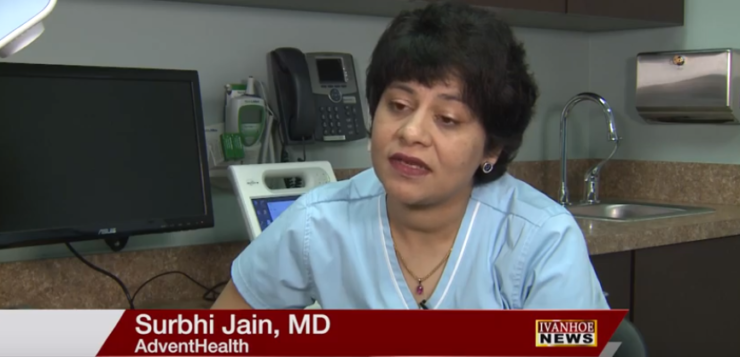Surbhi Jain, MD, from AdventHealth, talks about Carbon Monoxide poisoning.
Interview conducted by Ivanhoe Broadcast News in January 2019.
Can you tell us how dangerous that can be? And elaborate a little bit on that.
Surbhi: Carbon monoxide is a deadly, poisonous gas that is odorless, colorless, and invisible. Specifically, in poorly ventilated systems, it is the main byproduct of any carbon-related material that is burning or has incomplete combustion. It floats and spreads around in our homes, workplaces, cars, and has a unique toxic component that can cause irreversible damage to our body. This is why it’s called the silent killer, but thankfully the spread of this gas can be easily stopped.
How does somebody know that they even have carbon monoxide poisoning?
Surbhi: That’s a very good question. Most of the time, people don’t realize that they are accumulating carbon monoxide in their body. When carbon monoxide levels are low, people may experience flu-like symptoms such as headaches, confusion, malaise, nausea and even vomiting. However, when levels are too high, some internal organs may experience symptoms, such as neurological problems, cardiac problems, chest pain, and in some cases, the patient may present himself or herself to the ER with an MI. Therefore if someone, who has been exposed to the burning of carbon based materials in a poorly ventilated environment exhibits flu-like symptoms or a change in behavior, it is likely that carbon monoxide is a cause.
Tell us a little bit about how it can be treated
Surbhi: First and foremost, if carbon monoxide is suspected, immediately remove the patient from the potential source and bring them to fresh, open air to allow them to breathe. If the person is unresponsive, faces trouble in breathing, or has low blood pressure, phone 9-11 and shut down all appliances in the building. Then, without harming yourself, evacuate as many people in the building, starting with elderly people or children under the age of 5. Bring them to the E.R. so that they can be stabilized and treated.
How does the hyperbaric oxygenator work?
Surbhi: The treatment of carbon monoxide poisoning is to supply normal oxygen, which is very helpful in accelerating the elimination of carbon monoxide in the body. However, in some cases, patients may face more severe symptoms, especially cognitive, which may occur over a period of time after acute exposure. It may take a week to 14 days for the symptoms to appear, and in those cases, hyperbaric oxygen therapy can extremely helpful. Not only does it serve as a potential lifesaver, but it can also work on improving other neurological functions and mechanisms that were disturbed by carbon monoxide.
And how does it work?
Surbhi: Hyperbaric allows the patient to breath oxygen in a pressurized chamber. When the person is breathing 100% oxygen in a pressurizes system, it accelerates the elimination of carbon monoxide and interferes with the activation of white cells, which are in the blood and can be the source of oxidative injury from the carbon monoxide. Hyperbaric medicine serves to eliminate the hyperactivation of white blood cells. In brief, the hyperbaric acts upon the injury damage at the cellular level, thus aiding in the treatment of neurological symptoms in affected patients.
So is this good for somebody whose symptoms didn’t show up until two weeks later?
Surbhi: Right. It’s good especially in delayed cases, which we call subacute carbon monoxide poisoning. Here, the patient has a documented exposure to the carbon monoxide and may have been discharged from the E.R., but the neurological symptoms present after 7 to 10 days. Hyperbaric should be considered in relation to the intensity of the neurological symptoms. Another point to stress upon is the levels of carboxyhemoglobin. These are important in very acute situations where you measure these levels at the scene. But after a patient has been given some form of treatment, these levels only serve as an indicator or guide, but cannot dictate the following treatment decisions.
How common do you see common monoxide poisoning?
Surbhi: Over 40,000 patients a year present to the E.R. with carbon monoxide exposure, and about 450 to 500 patients die each year from the carbon monoxide poisoning. It is one of the leading toxic causes of death and half of the fatal poisoning deaths in our country are attributed to carbon monoxide poisoning. Recall that it is found in smoke inhalation, which is the main concerns in house fires, burning carbon-based materials, usage of propane-powered devices, or burning charcoal or wood in a poorly ventilated area. Children under the age of 5, elderly people, and pregnant females are more at risk of getting affected by carbon monoxide poisoning.
It’s 40,000 a year in the United States?
Surbhi: In the United States, around 40,000 patients are affected, and a very large number of these patients actually die from the accidental exposure as a result of a house fire, smoke inhalation, and suicide, too.
So how important is it to address this?
Surbhi: It is very important to address this, but it’s a simple job of people installing carbon monoxide detectors in addition to a smoke detector in their homes. It’s inexpensive and effective in detecting the levels of carbon monoxide in your house. Even low amounts of carbon monoxide would yield an alarm, whether it’s in broad daylight or in the middle of the night. This is one simple way that people can save themselves and their near and dear ones.
So any household items besides a car being left on in the garage? What’s the typical things in the house…
Surbhi: Anything gas-powered can emit carbon monoxide. However, gas leaks do not emit carbon monoxide; only gas powered systems that involve the combustion of the burning of gas can emit carbon monoxide.
If somebody’s like oh, we don’t have a gas powered anything in our house. Are they safer?
Surbhi: Yes. If they do not carry anything gas-powered, propane-powered, or anything similar and also don’t burn wood or charcoal in closed rooms, then they are safe. Also, if people don’t repair cars in enclosed garages, especially in cold conditions, they are safe. One important point to stress upon would be leaving cars on, as they bring a very deadly convenience. People tend to forget and ignorantly leave cars on in their garage. This is a major safety issue as the exhaust constantly spews gas into the house. Low levels of carbon monoxide would slowly get accumulated in your body, especially during sleep, as you are spending a long time in an unsafe environment. This is how carbon monoxide poisoning happens.
END OF INTERVIEW
This information is intended for additional research purposes only. It is not to be used as a prescription or advice from Ivanhoe Broadcast News, Inc. or any medical professional interviewed. Ivanhoe Broadcast News, Inc. assumes no responsibility for the depth or accuracy of physician statements. Procedures or medicines apply to different people and medical factors; always consult your physician on medical matters.
If you would like more information, please contact:
Ashley Jeffery
803-582-9648
ashley.jeffery@adventhealth.com
Sign up for a free weekly e-mail on Medical Breakthroughs called First to Know by clicking here.




